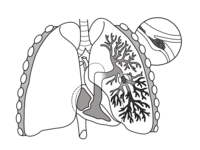
Histological features of intracranial thrombi in stroke patients with cancer
Sign Up to like & getrecommendations! Published in 2019 at "Annals of Neurology"
DOI: 10.1002/ana.25495
Abstract: The histological features of thrombus in stroke patients with cancer are not well known. Using immunohistochemical staining of thrombi retrieved during mechanical thrombectomy in stroke patients, thrombus compositions were compared between 16 patients with active… read more here.
Keywords: patients cancer; histological features; stroke patients; cancer ... See more keywords

Usefulness of Simplified Pulmonary Embolism Severity Index Score for Identification of Patients With Low-Risk Pulmonary Embolism and Active Cancer
Sign Up to like & getrecommendations! Published in 2020 at "Chest"
DOI: 10.1016/j.chest.2019.08.2206
Abstract: Background The simplified Pulmonary Embolism Severity Index (sPESI) score is a practical score for identification of patients with low-risk pulmonary embolism (PE), although it has not been applied in patients with active cancer. The current… read more here.
Keywords: patients spesi; pulmonary embolism; cancer; spesi score ... See more keywords

Atrial fibrillation in active cancer patients: expert position paper and recommendations.
Sign Up to like & getrecommendations! Published in 2019 at "Revista espanola de cardiologia"
DOI: 10.1016/j.rec.2019.03.019
Abstract: Improvements in survival among cancer patients have revealed the clinical impact of cardiotoxicity on both cardiovascular and hematological and oncological outcomes, especially when it leads to the interruption of highly effective antitumor therapies. Atrial fibrillation… read more here.
Keywords: atrial fibrillation; cancer; cancer patients; oncology ... See more keywords

Cancer-associated ischemic stroke: A retrospective multicentre cohort study.
Sign Up to like & getrecommendations! Published in 2018 at "Thrombosis research"
DOI: 10.1016/j.thromres.2018.03.011
Abstract: BACKGROUND The association between stroke and cancer is well-known but insufficiently investigated. Aim of this multicentre retrospective cohort study was to estimate the prevalence of cancer-associated ischemic stroke, describe clinical outcomes in patients with cancer-associated… read more here.
Keywords: ischemic stroke; associated ischemic; cancer; cancer associated ... See more keywords

Economic burden of cancer from 2012 to 2017 based on the French national claim database (SNDS)
Sign Up to like & getrecommendations! Published in 2019 at "European Journal of Public Health"
DOI: 10.1093/eurpub/ckz185.051
Abstract: The aim of this study is to assess the economic burden of active cancer in France and to analyze structure and trends of expenditure between 2012 and 2017. Using information about 57 millions of individuals… read more here.
Keywords: 2012 2017; economic burden; expenditure; cancer ... See more keywords

Exploring Young People’s Experience of Ending Active Cancer Treatment
Sign Up to like & getrecommendations! Published in 2020 at "Cancer Nursing"
DOI: 10.1097/ncc.0000000000000798
Abstract: Background The end of active cancer treatment is described as a stressful period for adolescents and young adults (AYAs). However, research evidence describing the experience of AYAs as they transition from active treatment into follow-up… read more here.
Keywords: ending active; treatment; cancer; young people ... See more keywords

Predictors of active cancer thromboembolic outcomes: validation of the Khorana score among patients with lung cancer: comment
Sign Up to like & getrecommendations! Published in 2017 at "Journal of Thrombosis and Haemostasis"
DOI: 10.1111/jth.13594
Abstract: 1 South K, Freitas MO, Lane DA. Conformational quiescence of ADAMTS-13 prevents proteolytic promiscuity. J Thromb Haemost 2016; 14: 2011–22. 2 South K, Luken BM, Crawley JT, Phillips R, Thomas M, Collins RF, Deforche L,… read more here.
Keywords: cancer thromboembolic; thromboembolic outcomes; predictors active; cancer ... See more keywords

Score for Predicting Active Cancer in Patients with Ischemic Stroke: A Retrospective Study
Sign Up to like & getrecommendations! Published in 2021 at "BioMed Research International"
DOI: 10.1155/2021/5585206
Abstract: Background We aimed to examine the differences of clinical characteristics between patients with ischemic stroke with active cancer and those without cancer to develop a clinical score for predicting the presence of occult cancer in… read more here.
Keywords: ischemic stroke; patients ischemic; cancer; cancer patients ... See more keywords

Cancer-Associated Hypercoagulation Increases the Risk of Early Recurrent Stroke in Patients with Active Cancer
Sign Up to like & getrecommendations! Published in 2018 at "Cerebrovascular Diseases"
DOI: 10.1159/000491436
Abstract: Background: This study assessed the incidence and predictors of short-term stroke recurrence in ischemic stroke patients with active cancer, and elucidated whether cancer-associated hypercoagulation is related to early recurrent stroke. Methods: We retrospectively enrolled acute… read more here.
Keywords: cancer; stroke patients; recurrent stroke; active cancer ... See more keywords

High in-hospital mortality in SARS-CoV-2 infected patients with active cancer disease during Omicron phase of the pandemic - Insights from the CORONA Germany Study.
Sign Up to like & getrecommendations! Published in 2023 at "Oncology research and treatment"
DOI: 10.1159/000529788
Abstract: INTRODUCTION SARS-CoV-2 infected patients with cancer have a worse outcome including a significant higher mortality, compared to non-cancer patients. However, limited data are available regarding in-hospital mortality during the Omicron phase of the pandemic. Therefore,… read more here.
Keywords: active cancer; cancer disease; mortality; cancer ... See more keywords

COSIMO – patients with active cancer changing to rivaroxaban for the treatment and prevention of recurrent venous thromboembolism: a non-interventional study
Sign Up to like & getrecommendations! Published in 2018 at "Thrombosis Journal"
DOI: 10.1186/s12959-018-0176-2
Abstract: BackgroundAround 20% of venous thromboembolism (VTE) cases occur in patients with cancer. Current guidelines recommend low molecular weight heparin (LMWH) as the preferred anticoagulant for VTE treatment. However, some guidelines state that vitamin K antagonists… read more here.
Keywords: vte; treatment; rivaroxaban treatment; cosimo ... See more keywords